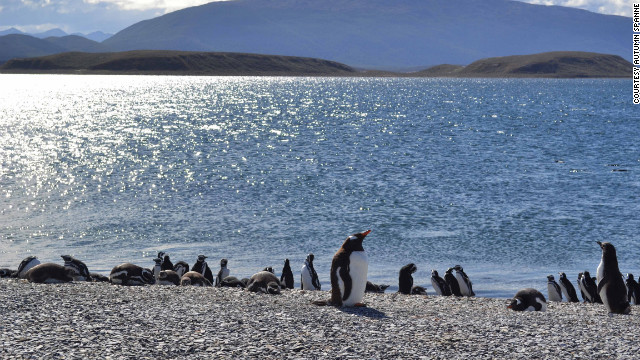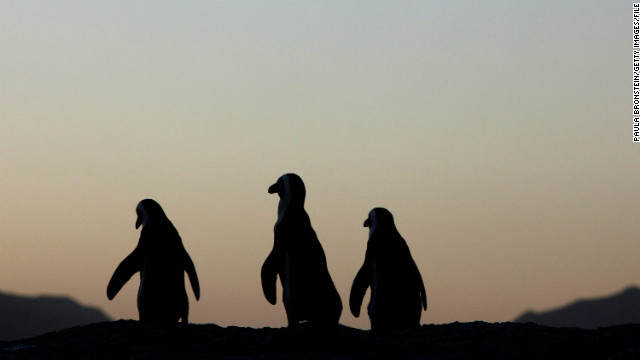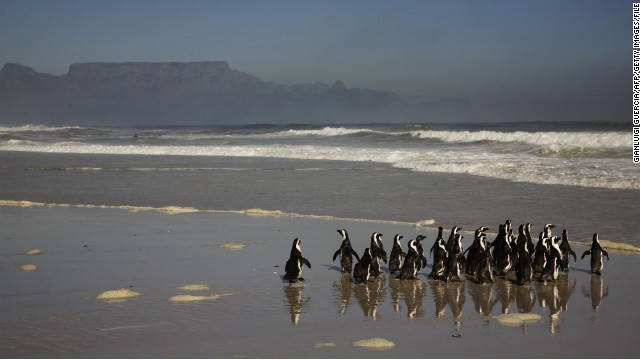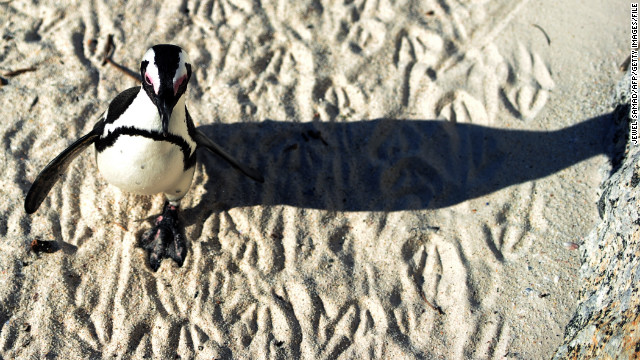Mon January 14, 2013
 Gentoo and Magellanic penguins mingle in Tierra del Fuego, Argentina.
Gentoo and Magellanic penguins mingle in Tierra del Fuego, Argentina.  Gentoo penguins, seen here in Argentina, have orange beaks.
Gentoo penguins, seen here in Argentina, have orange beaks.
 The smallest
penguin species, known as little penguins or fairy penguins, lives only
in Australia and New Zealand. This little guy was photographed in
Australia's Phillip Island Nature Park.
The smallest
penguin species, known as little penguins or fairy penguins, lives only
in Australia and New Zealand. This little guy was photographed in
Australia's Phillip Island Nature Park.
 Little penguins weigh less than three pounds.
Little penguins weigh less than three pounds.
Penguins around the world
 African penguins walk along the rocks at sunset in Table Mountain National Park near Cape Town, South Africa.
African penguins walk along the rocks at sunset in Table Mountain National Park near Cape Town, South Africa.
 Penguins walk toward the ocean on Blouberg Beach outside of Cape Town.
Penguins walk toward the ocean on Blouberg Beach outside of Cape Town.
 The African penguin is also known as the black-footed penguin.
The African penguin is also known as the black-footed penguin.- November through March is prime season for penguin viewing
- From Argentina to Australia, penguin tours allow travelers to see them in the wild
- Responsible tours to see penguins support conservation
From the windswept
beaches of Tierra del Fuego at South America's tip to sunny Cape Town,
South Africa, and Melbourne, Australia, penguin colonies exist in many
strikingly beautiful destinations in the Southern Hemisphere.
There's no denying it:
Penguins are among the most charismatic creatures. Their notorious
curiosity, waddling gait and comical body language seldom fail to charm.
But these flightless sea birds have evolved over 15 million years to
become strong, nimble swimmers that often migrate long distances in
pursuit of fish following seasonal ocean currents.
Today, most of the 18
species of penguins are in decline because of climate change, habitat
destruction, pollution and overfishing -- in fact, more than half are
considered endangered. You can support their survival by visiting
carefully managed colonies where tour operators respect penguin habitat
and educate visitors about conservation efforts.
Penguin viewing etiquette
To minimize disruptions to penguins and their habitat, follow these common-sense guidelines:
Pay close attention to your guide's instructions about body language and maintaining a safe distance from penguins
Do not approach or touch penguins
Move slowly and speak softly
No flash photography
Keep clear of nests and chicks
Stick to designated paths
Leave no trace
November through March --
when it's the warmest in the Southern Hemisphere -- is prime time for
viewing many penguin species. During the warm season, they spend more
time on shore to breed, nest and raise their young.
Check out these amazing penguin spots:
Tierra del Fuego (Argentina and Chile)
Ushuaia, Argentina, the
southernmost city in the world, boasts several tour operators offering
day cruises to view penguins and other marine life. But only one,
PiraTour, gives visitors the chance to walk among the penguins.
PiraTour runs two
six-hour tours daily from the port of Ushuaia. Tours are limited to 20
people, so be sure to make reservations well in advance. A 90-minute
minivan ride takes visitors through Patagonian forests and along
secluded pebbly coves before arriving at Estancia Harberton, a charming
family-owned farm and marine center. From there, visitors transfer to a
boat for a short ride to Isla Martillo, a research station that monitors
the 3,000 pairs of Magellanic penguins and a small colony of gentoo
penguins that nest here between September and April.
Visitors will spend up
to an hour observing the very vocal Magellanic penguins, which bellow
and strut along the beach by the hundreds. The tour guide will instruct
you to maintain a safe distance from the birds, but be prepared for them
to approach you as penguins can be extremely curious. After a few
minutes on the beach, you'll be led up a bluff to see their nesting
ground, where the birds often return to the same mate and same nest year
after year.
Back at Estancia Harberton,
you'll have time to grab a hot drink at the tea room or explore the
farm's on-site marine research center. There is also a guest house and
camp sites; contact Harberton directly if you want to extend your visit
to this peaceful haven. Otherwise, Ushuaia offers a wide range of
accommodation options, from backpacker hostels to luxury hotels perched
on glacial mountainsides overlooking the city.
PiraTour, U.S. $95 for a six-hour tour (50% discount for children under 12), plus $13 entry fee to Estancia Harberton
Phillip Island, Australia
Since the 1920s,
tourists have flocked to Phillip Island to witness the smallest penguin
species, known as little penguins or fairy penguins, return to shore
each evening to feed their young after a long day of fishing. Only 12
inches tall and weighing less than 3 pounds, the little penguin is found
only in Australia and New Zealand.
For decades, the
penguins on Phillip Island were largely unprotected from the throngs of
sightseers, but today most visitors observe the evening penguin "parade"
from elevated boardwalks and viewing platforms to minimize disturbances
to the birds.
For those who want a
more up-close-and-personal experience, a limited number of tickets are
available each day for small group, ranger-guided tours where you can
walk among penguins on a secluded beach. The ticket price helps support
conservation work on the island, including habitat restoration and
research focusing on how penguins are affected by climate change,
development and invasive species.
Phillip Island is a
90-minute drive from Melbourne, but plan on spending at least a couple
of days here to enjoy all its wildlife, including koalas, wallabies,
elusive anteaters, seals and whales.
Phillip Island Nature Park,
prices start at U.S. $23 for evening viewing from a platform, $46 for
close-up viewing and $82.50 for a private, ranger-guided ecoadventure in
a part of the penguin colony that's closed to the general public.
Cape Town, South Africa
The southern tip of
Africa offers numerous opportunities to view the African penguin,
previously known as the jackass penguin because of its distinctive
donkey-like bray.
African penguins have declined by 80%
in the past 50 years because of pollution, development, climate change
and irresponsible tourism activities. The Boulders Beach colony, about
24 miles from Cape Town, was only established in 1983, but it's now an
important habitat for the endangered bird.
As its name suggests,
the beach is strewn with granite boulders, which create an impressive
backdrop for photographing the penguins. Today, boardwalk viewing areas
help protect the birds from excessive human contact, although you may
encounter penguins while swimming and should take care not to approach
them if possible.
Boulders Beach is part
of Table Mountain National Park, situated at the convergence of the
Atlantic and Indian oceans on the Cape of Good Hope. Hiking, mountain
biking, wind sailing and wildlife viewing are just a few of the
activities here that offer impressive views of Cape Town and the
surrounding countryside. The nearby village of Simon's Town, with its
historic cottages and cobblestone streets, provides numerous
accommodation and dining options.
Table Mountain National Park, visitors to the park pay a daily conservation fee of U.S. $5.30 per adult and $2.50 per child.
Otago Peninsula, New Zealand
Even in a country known
for its dramatic scenery and amazing wildlife, the Otago Peninsula
stands out. Located on New Zealand's South Island, the peninsula was
born of volcanic eruptions that created steep mountains and rugged sea
cliffs. It's a hot spot for marine wildlife viewing -- seals, sea lions,
elephant seals and, of course, penguins. Here it's possible to see both
the little penguin and the rare yellow-eyed penguin.
A number of tour
operators on the peninsula are committed to environmental education and
sustainable ecotourism. Nature Guides Otago offers naturalist-led tours
as well as lodging that emphasize sustainability and support penguin
habitat restoration and conservation.
Another option is
Penguin Place, a conservation reserve on a private farm. Visitors begin
the tour by learning about penguin conservation efforts before
proceeding to a series of trenches and observation huts. From these
vantage points, they are treated to up-close views of a yellow-eyed
penguin colony while minimizing disturbances to the birds, which live in
coastal forests and have suffered significant habitat loss from
logging.
Nature Guides Otago,
a sunrise tour of a yellow-eyed penguin colony, maximum six people,
runs U.S. $75 per person. Nature packages, which include two nights at a
B&B cottage, sunrise penguin tour and a daylong tour of the Otago
Peninsula, run $540 per person. Note that tour priority is given to
those staying at the cottage.
Penguin Place,
penguin tours run throughout the day. Price is U.S. $41 for adults and
$10 for children. Budget accommodations are available at the Penguin
Place Lodge for U.S. $22 adults, $8.50 children
Galapagos Islands, Ecuador
It comes as a surprise
to most travelers that a trip to the Galapagos could include the chance
to see penguins. But in fact, the islands are home to the only penguin
that lives in a tropical climate. Unlike other species that migrate
according to the season, endangered Galapagos penguins live here
year-round, especially in the colder waters of the western islands such
as Isla Isabela.
Almost any tour of the
Galapagos includes the chance to see an incredible variety of wildlife,
but some operators specifically offer penguin tours. More likely than
not you'll be observing the birds from a boat, but if the tour includes
snorkeling in an area frequented by penguins, there's a chance that you
could end up swimming with the birds.
source
source


















No comments:
Post a Comment